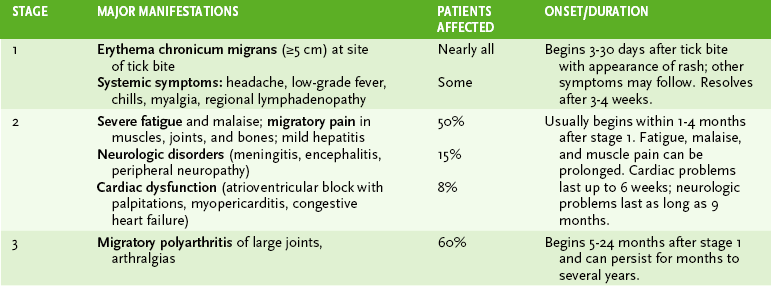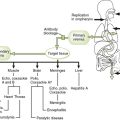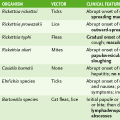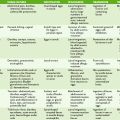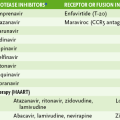Spirochetes
• The pathogenic treponemes (T. pallidum, T. pertenue, and T. carateum) cannot be distinguished morphologically or serologically, but they exhibit distinctive clinical manifestations and epidemiology.
A Shared treponemal properties
1. Treponemes are shorter than Borreliae and possess three axial filaments.
2. Anaerobic (or microaerophilic) organisms that cannot be grown in the laboratory
• Because they are so thin, treponemes cannot be seen by light microscopy of Giemsa-stained specimens.
• Organisms can be visualized by dark-field microscopy or by fluorescence microscopy of specimens stained with fluorescent-labeled antitreponemal antibody.
• Nontreponemal tests (nonspecific for tissue damage)
• Treponemal tests (specific for antibody to Treponema antigens)
• After adherence to skin or mucosal membranes, treponemes produce hyaluronidase, which promotes tissue invasion.
• Organisms become coated with host fibronectin, which protects them against phagocytosis and immune recognition.
• Soon after infection, treponemes spread to other skin sites and to other organs via the bloodstream.
• Host immune response is largely responsible for disease manifestations.
• T. pallidum causes syphilis, the most common treponemal disease.
1. Clinical course of syphilis
a. Chancre, a painless ulcerated skin lesion, develops at the site of inoculation (usually external genitals, mouth, or anus).
b. Painless swollen lymph glands (buboes) develop 1 to 2 weeks after the appearance of the chancre.
c. Spontaneous healing of the chancre occurs within 3 to 6 weeks but does not indicate a cure.
• Secondary syphilis (bacteremic stage)
a. Highly contagious, disseminated maculopapular rash develops over the entire body surface.
b. Flu-like syndrome, with sore throat, headache, fever, myalgia, anorexia, and generalized lymphadenopathy, accompanies the rash.
c. Treponemes become dormant in liver and spleen.
• Flat lesions in the anogenital area often confused with condyloma acuminata (venereal warts) caused by human papillomavirus 6, 11
e. Symptoms usually resolve within 6 to 8 months of infection.
a. Activation of dormant treponemes and their multiplication 3 to 30 years later occur in a small number of untreated cases.
b. Gummas (destructive granulomatous lesions) form in bone, skin, and other tissues.
c. Neurosyphilis (tabes dorsalis) and cardiovascular syphilis (aortitis) are life-threatening conditions that may develop.
1. Subspecies T. pallidum pertenue causes yaws, which is found in regions of South America, central Africa, and Southeast Asia.
• T. pertenue causes yaws, and T. carateum causes pinta; tropical treponemal diseases; initial skin lesions, spread by nonsexual contact
2. This granulomatous disease is marked early by elevated papilloma-like skin lesions and later by destructive lesions of the skin, lymph nodes, and bones.
1. Bacteria in this genus are larger than treponemes and possess numerous axial filaments.
2. Like treponemes, borreliae are microaerophilic organisms that are difficult to culture.
• B. burgdorferi, the cause of Lyme disease, is spread by tick vectors.
• Too few borreliae are present in clinical specimens to visualize the organisms by light microscopy.
• Enzyme-linked immunosorbent assay or other serologic tests to detect B. burgdorferi antibodies become positive 2 to 4 weeks after onset of the initial rash.
• Because false-positive serologic tests are common, a second test (e.g., Western blot) is needed to confirm B. burgdorferi infection.
• A tick (bite) deposits borreliae in the skin and blood, and the organisms spread to multiple organs.
• Host immune response primarily causes disease manifestations.
3. Clinical course of Lyme disease (Table 15-1)
• Like syphilis, Lyme disease follows a three-stage course, although overall its duration in untreated patients is shorter than that of syphilis.
• Louse-borne (epidemic) relapsing fever is caused by B. recurrentis.
• Tick-borne (endemic) relapsing fever is caused by several other Borrelia species.
• Febrile (bacteremic) phase is marked by abrupt onset of high fever, shaking chills, headache, and muscle aches and lasts 3 to 7 days.
• Afebrile phase lasts about 1 week, and then bacteremic symptoms return.
• Alternating febrile and afebrile phases that characterize relapsing fever result from antigenic variation that occurs during the course of infection.
1. Leptospires, the smallest of the spirochetes, are aerobic organisms with hooked ends that can be visualized by dark-field microscopy.
2. L. interrogans is the only species pathogenic in humans.
3. Rats and other rodents and domestic animals (household pets) carry L. interrogans and shed organisms in the urine.
1. Usually a mild flu-like infection, is acquired by contact with contaminated water or the urine or tissues of infected animals
2. Weil syndrome, a severe form of leptospirosis, develops in about 10% of infected patients.

